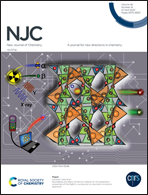Hybrid photoluminescent material from lanthanide fluoride and graphene oxide with strong luminescence intensity as a chemical sensor for mercury ions†
Abstract
Herein, we unveil a novel graphene oxide lanthanide fluoride hybrid nanomaterial. As synthesized NaxLiyGdF4:Tb3+ nanophosphor was functionalized with pyromellitic acid (PMA) and 1,10-phenanthroline (Phen) and deposited on the surface of graphene oxide (GO) through a non-covalent approach. PMA and Phen play key roles in improving the photoluminescence intensity and prolonging the lifetime decay of the hybrid nanomaterial. The NaxLiyGdF4:Tb3+@PMA@Phen@GO nanomaterial was used for the detection of toxic metals ions such as Hg, Ni, Co, Pb and Mn due to its superior optical properties. The selective and sensitive detection of Hg2+ is of considerable interest because Hg2+ can cause serious environmental damage and fatal diseases. Luminescent measurements show that the luminescent nanosensor exhibits a selective turn-off response to Hg2+ over other toxic metals. Under optimized conditions, the NaxLiyGdF4:Tb3+@PMA@Phen@GO sensor could effectively determine Hg2+ ions with a low detection limit of 1.03 ppm and KSV value of 3.65 × 105 M−1. The lower detection limit (LOD) and higher Stern–Volmer constant (KSV) values compared to the other target metal ions indicate the high sensitivity and selectivity of the fabricated chemical sensor towards Hg2+ ions. The fabricated nanocomposite exhibits stronger interaction with Hg2+ due to the Phen ligand, thereby disturbing the antenna effect originating from the Phen ligand. The presence of other metal ions does not hinder the detection of Hg2+ ions.



 Please wait while we load your content...
Please wait while we load your content...